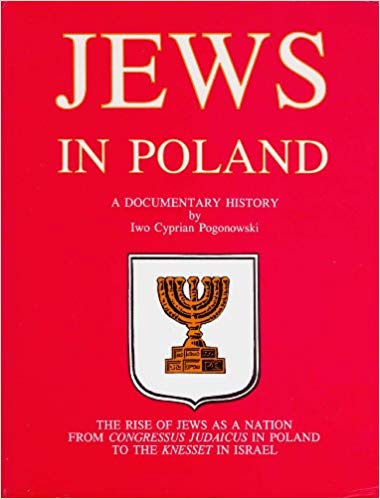Judeopolonia WWI Kielce Pogrom Pogonowski

Jews in Poland, by Iwo Cyprian Pogonowski. 1998
The Reality of a WWI Judeopolonia. The Soviet-Staged Kielce Pogrom: Why and How
This 1998 edition contains several articles not found in the original hardback edition. The authors trace many mischaracterizations of Polish-Jewish history in the American press. The informed reader can appreciate how little has changed since then. For example, the publications of NEIGHBORS, FEAR, and GOLDEN HARVEST, by Jan T. Gross, and the media-acclaimed winners written by the likes of Anna Bikont, Jan Grabowski, and Barbara Engelking, have kept reviving Polonophobic canards that should have been, if nowhere else, laid to rest by this 1998 edition. And here it is 2019, and they continue. Some things never change.
JEWISH GERMANOPHILIA: JUDEOPOLONIA WAS A VERY REAL POSSIBILITY
Historian Iwo Pogonowski shows, in detail (pp. 296-297) how the pro-German Zionists formed the Zionist Association in Germany in 1897, and how they opposed the resurrection of the Polish state. Instead, Max Bodenheimer, its president, proposed the creation of a German Protectorate out of the western parts of formerly Russian-ruled Poland. (The German-ruled and Austrian-ruled parts of Poland would remain the same). The new German protectorate would fulfill a literal Judeopolonia. That is, Polish territory would become German and Jewish ruled; the latter facilitated by the Germanophilia orientation of many Jews living on Polish soil, the abundance of Jews in influential positions, the affinities of Yiddish to the German language, etc. For a time, famous Jewish philosopher Martin Buber supported this plan. The reader can clearly see that the concept of Judeopolonia (Judeo-Polonia) was not simply an anti-Semitic fantasy: It had some basis in fact. For more details, see my review of Max Bodenheimer’s work.
WHY THE KIELCE POGROM WAS STAGED
This work contains an extensive expose of the so-called Kielce Pogrom. (pp. 403-422). The Soviets wanted to discredit a free Poland in the eyes of the west, and to terrorize the remaining Jews into fleeing to Palestine. Other anti-Jewish actions in Hungary and Czechoslovakia got little press in the west, probably because anti-Communism had been relatively weak in those countries. The Soviet Union clearly had the motive, means, and opportunity to make Kielce a black spot on Poland. Multiple, overlapping circumstantial evidence points to Soviet staging, as elaborated next.
HOW THE KIELCE POGROM WAS STAGED
In Kielce, the tale of the blood libel had been spread by agent provocateurs (p. 414). The Jews were shot by Communist police U. B., or Bezpieka), and club-wielding fake “steel workers” also took their toll. Other Communist police involved in the so-called pogrom had been dressed as goons or priests. There is the fantastic myth of the 15,000 to 75,000 cheering Polish onlookers (p. 406), a myth recently repeated by neo-Stalinist Jan T. Gross in his FEAR. The actual number of Polish onlookers, most of whom were probably motivated by curiosity, didn’t ever exceed several hundred at its peak. After the “pogrom”, inconvenient eyewitnesses met their deaths. The Kielce files themselves were burned in November 1989, shortly before the Communists left power. I wonder why.
STOP BLAMING POLAND FOR THE SITUATION OF JEWS IN MARCH 1968
Pogonowski makes clear that the Communist anti-Jewish policies of 1968 were not Polish. They were plainly Soviet-dictated. (pp. 30-31).
To see a series of truncated reviews in a Category click on that Category:
- All reviews
- Anti-Christian Tendencies
- Anti-Polish Trends
- Censorship on Poles and Jews
- Communization of Poland
- Cultural Marxism
- German Guilt Dilution
- Holocaust Industry
- Interwar Polish-Jewish Relations
- Jewish Collaboration
- Jewish Economic Dominance
- Jews Antagonize Poland
- Jews Not Faultless
- Jews' Holocaust Dominates
- Jews' Holocaust Non-Special
- Nazi Crimes and Communist Crimes Were Equal
- Opinion-Forming Anti-Polonism
- Pogrom Mongering
- Poland in World War II
- Polish Jew-Rescue Ingratitude
- Polish Nationalism
- Polish Non-Complicity
- Polish-Ukrainian Relations
- Polokaust
- Premodern Poland
- Recent Polish-Jewish Relations
- The Decadent West
- The Jew as Other
- Understanding Nazi Germany
- Why Jews a "Problem"
- Zydokomuna